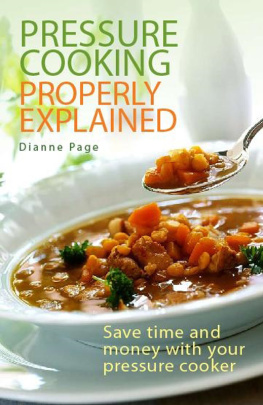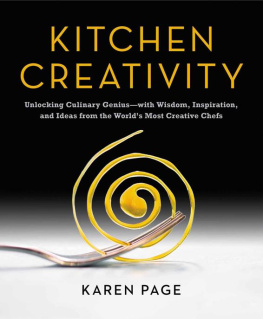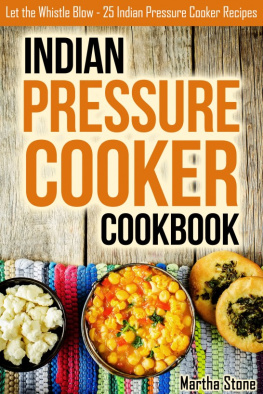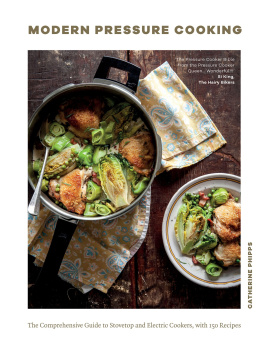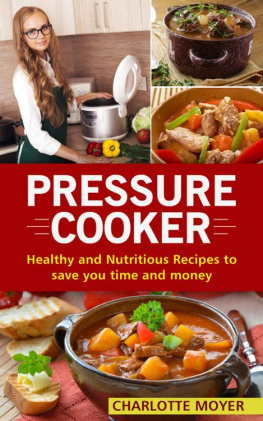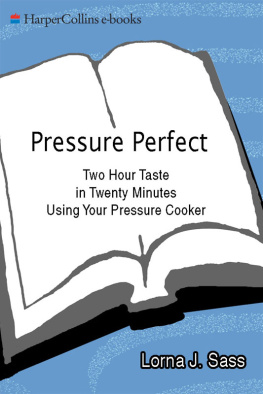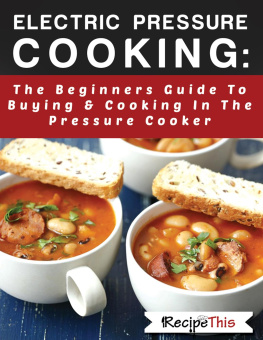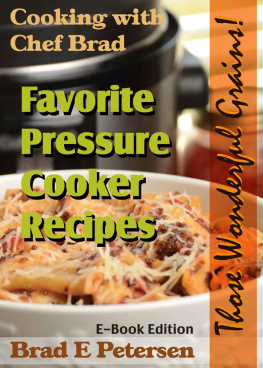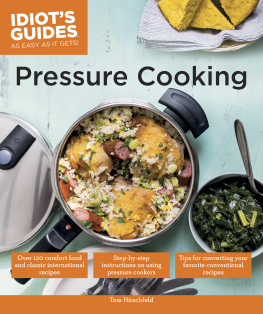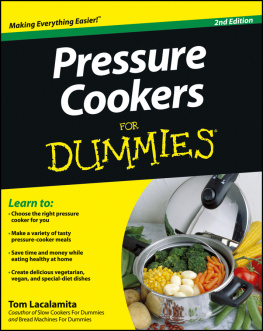PRESSURE COOKING
PROPERLY EXPLAINED
WITH RECIPES
By the same author
Slow Cooking Properly Explained
Food Processors Properly Explained
Illustrations by Emma Thomas
Where to find Right Way
Elliot Right Way take pride in our editorial quality, accuracy and value-for-money. Booksellers everywhere can rapidly obtain any Right Way book for you. If you have been particularly pleased with any one title, do please mention this to your bookseller as personal recommendation helps us enormously.
Please send to the address on the back of the title page opposite, a stamped, self-addressed envelope if you would like a copy of our free catalogue. Alternatively, you may wish to browse through our extensive range of informative titles arranged by subject on the Internet at www.right-way.co.uk
We welcome views and suggestions from readers as well as from prospective authors; do please write to us or e-mail:
Constable & Robinson Ltd.
5556 Russell Square
London WC1B 4HP
www.constablerobinson.com
First published in the UK 1978
This new edition published by Right Way, an imprint of Constable & Robinson, 2009
Copyright Constable & Robinson, 2009
All rights reserved. This book is sold subject to the condition that it shall not, by way of trade or otherwise, be lent, re-sold, hired out or otherwise circulated in any form of binding or cover other than that in which it is published and without a similar condition including this condition being imposed on the subsequent purchaser.
A copy of the British Library Cataloguing in Publication Data is available from the British Library
ISBN: 978-0-7160-2232-9
eISBN: 978-0-7160-2360-9
Printed and bound in the EU
3 5 7 9 10 8 6 4 2
Cover photo: S Lee Studios/ www.photolibrary.com ;
Cover design: Stonecastle Graphics
CONTENTS
INTRODUCTION
This book is particularly for newcomers to pressure cooking and for those of you whose pressure cooker is languishing unused at the back of a cupboard. It contains a wide variety of recipes that are sure to appeal and encourage you to try pressure cooking for yourself. Readers who are already fans of pressure cooking will find all their favourite recipes and plenty more.
Thankfully, the old wives tales about exploding pressure cookers are a relic of the past. Todays cleverly designed models make sure to put your safety first.
My first pressure cooker was a wedding present. After preparing two or three meals, carefully following instructions, I soon found that pressure cooking is straightforward and gives excellent results, quickly and conveniently. It wasnt long before the pressure cooker became a way of life just one more pan in the kitchen. The secret is to keep it handy, for there is no truer saying than out of sight, out of mind. You too will find that pressure cooking can be an ideal, if not essential, part of a busy life. So discover for yourself how the speed of pressure cooking can extend a busy cooks repertoire to include homely everyday meals, as well as more adventurous menus.
Advantages of Pressure Cooking
Speedy
If you have never used a pressure cooker before, you will be amazed at the short cooking times. Cooking under pressure generally takes roughly one quarter to one third of the conventional cooking time. In some recipes the time saving is even greater and can be quicker than in a microwave. For example, a beef stew that normally takes about 1 hours to cook conventionally can be pressure cooked in 1520 minutes.
The speed of pressure cooking means that those traditional well-loved recipes, often neglected because they need hours of cooking or close attention, can be prepared quickly and easily. Old favourites like Steak and Kidney Pudding, Steamed Suet Pudding and Lemon Curd are good examples. Dried pulses (peas and beans) can be cooked in a fraction of the normal time too.
Economical
The shorter cooking times inevitably result in fuel savings. Remember too that, once the required cooking pressure has been reached, the heat is usually turned down to minimum setting for the remainder of the cooking time.
Even greater savings can be made if you cook more than one kind of food in the pressure cooker at the same time a great advantage if you cook mainly for one or two or if you are keen to economise. Turn to for some suitable menu ideas for one.
Pressure cooking can be economical when cooking for crowds too, or when bulk cooking for the freezer. It is often worthwhile cooking double the amount you need and freezing half (the additional time taken to prepare extra ingredients is negligible). Remember that increasing the quantity of ingredients (particularly in soups and stews) does not usually result in a longer pressure cooking time. The time only needs adjusting if you increase the size of foods such as meat joints or steamed puddings. The main point to remember is never to over-fill the pressure cooker.
Savings dont stop with fuel either. A pressure cooker will quickly cook cheaper cuts of meat the ones that are packed with flavour but normally need long slow cooking to make them tender. Dried beans, usually a cheap source of protein, can be pressure cooked in just 20 minutes.
Improved Flavour, Colour and Nutrition
We all recognise the welcoming aroma of a delicious casserole bubbling away gently in the oven or on the hob, but its easy to forget that, along with the steam, some of the flavour is also escaping. A pressure cooker is designed to seal in the steam and, as a result, retain most of the flavour.
Pressure cooking also helps to prevent the loss of colour that occurs in long, slow cooking particularly in vegetables.
No matter how food is cooked, its inevitable that a certain amount of nutritional value will be lost. Nevertheless, the short cooking times in a pressure cooker, combined with the small quantity of liquid and the absence of light and air, help to retain vitamins and minerals which might normally be lost.
Less Steam and Reduced Cooking Smells
A pressure cooker allows only a small amount of steam to escape, which enables you to cook steamed puddings and stews without the windows running with condensation. Cooking smells in the kitchen are reduced for the same reason.
A Boon for Camping, Caravanning and Boating
A pressure cooker is invaluable on self-catering holidays where time and space for cooking are at a premium.
Pressure Cooking Explained in Brief
When cooking in a saucepan, heat is lost as steam escapes from under the lid. A pressure cookers lid fits so closely that an airtight seal is formed, trapping in the steam and allowing pressure to build up inside.
When water boils in a saucepan it is impossible for it to become hotter than boiling point (100C). If water is heated under pressure, it is possible to increase that temperature and therefore cook the food more quickly.
Todays popular pressure cookers operate at three different pressures: Low (5 lb per square inch), Medium (10 lb per square inch) and High (15 lb per square inch) pressure. At Low pressure, water reaches 109C; at Medium 115C; and at High 121C. Since most food is usually pressure cooked at High pressure, you can appreciate how that extra 21C helps to speed up cooking significantly.
Choosing a Pressure Cooker
All pressure cookers work on the basic principle described above. How they usually differ is in the way they operate. Some pressure cookers have a choice of three different pressures (see above), some have two, while some older models have only one fixed pressure.

